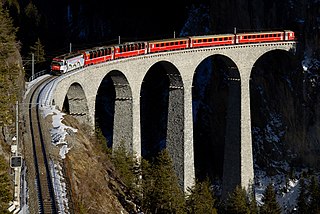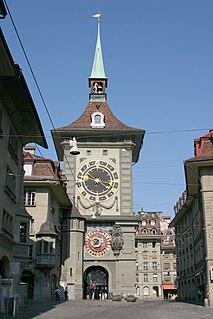 W
WThe Abbey of Saint Gall is a dissolved abbey (747–1805) in a Catholic religious complex in the city of St. Gallen in Switzerland. The Carolingian-era monastery has existed since 719 and became an independent principality between 9th and 13th centuries, and was for many centuries one of the chief Benedictine abbeys in Europe. It was founded by Saint Othmar on the spot where Saint Gall had erected his hermitage. The library of the Abbey is one of the oldest monastic libraries in the world. The city of St. Gallen originated as an adjoining settlement of the abbey. Following the secularization of the abbey around 1800, the former Abbey church became a Cathedral in 1848. Since 1983 the abbey precinct has been a UNESCO World Heritage Site.
 W
WAugusta Raurica is a Roman archaeological site and an open-air museum in Switzerland located on the south bank of the Rhine river about 20 km east of Basel near the villages of Augst and Kaiseraugst. It is the site of the oldest known Roman colony on the Rhine.
 W
WThe Brunswick Monument is a mausoleum built in 1879 in the Jardin des Alpes in Geneva, Switzerland to commemorate the life of Charles II, Duke of Brunswick (1804–1873). He bequeathed his fortune to the city of Geneva in exchange for a monument to be built in his name, specifying that it be a replica of the Scaliger Tombs in Verona, Italy. The Grand Théâtre de Genève, opened in 1879, was built with the legacy.
 W
WThe Brusio spiral viaduct is a single-track nine-arched stone spiral railway viaduct on the Bernina railway. It was first opened on 1 July 1908.
 W
WThe grounds of the Palais des Nations contain many fine objects donated by member states of the United Nations, private sponsors and artists. The Celestial Sphere in the Ariana Park of the Palais des Nations is the best-known of these. The huge - over four meter diameter - Celestial Sphere is the chef d'oeuvre of the American sculptor Paul Manship (1885–1966). It was donated in 1939 by the Woodrow Wilson Foundation to what was then the League of Nations building. Known also as the Woodrow Wilson Memorial Sphere of the Palais des Nations it is today a symbol of Geneva International and of Geneva as the centre of dialogue and peace.
 W
WThe Dreiländereck is a monument in Basel, Switzerland. It marks the tripoint where the borders of France, Germany and Switzerland meet. The France–Germany border, the Germany–Switzerland border and France–Switzerland border meet there.
 W
WFork of Vevey is an 8-metre-tall (26 ft), 1.3-metre-wide (4.3 ft) stainless steel fork on the shore of Lake Geneva in Vevey, Switzerland. Fork of Vevey is a part of the Alimentarium, a Vevey-based museum with a permanent exhibition on food and Nestlé's history.
 W
WThe Goetheanum, located in Dornach, in the canton of Solothurn, Switzerland, is the world center for the anthroposophical movement.
 W
WThe Hammetschwand Lift is the highest exterior elevator in Europe and is located in Switzerland. It connects a rock path with the lookout point Hammetschwand on the Bürgenstock plateau overlooking Lake Lucerne.
 W
WThe Hedwig Fountain or Lindenhof Fountain is a fountain in the Lindenhof hill in Zürich, Switzerland, which was built in 1912. The helmeted statue of a woman beside the fountain was made by Gustav Siber. It was built to honor the Zürich women who defended the city by duping the army of Duke Albert I of Germany during the siege of Zürich in 1292. They dressed in full battle gear in order to trick the Habsburg army into thinking that the city was well protected while their men were busy campaigning at Winterthur.
 W
WThe Jet d'Eau is a large fountain in Geneva, Switzerland and is one of the city's most famous landmarks, being featured on the city's official tourism web site and on the official logo for Geneva's hosting of group stage matches in the 2008 UEFA Euro. Situated where Lake Geneva exits as the Rhône, it is visible throughout the city and from the air, even when flying over Geneva at an altitude of 10 kilometres (33,000 ft).
 W
WThe Kapellbrücke is a covered wooden footbridge spanning the river Reuss diagonally in the city of Lucerne in central Switzerland. Named after the nearby St. Peter's Chapel, the bridge is unique in containing a number of interior paintings dating back to the 17th century, although many of them were destroyed along with a larger part of the centuries-old bridge in a 1993 fire. Subsequently restored, the Kapellbrücke is the oldest wooden covered bridge in Europe, as well as the world's oldest surviving truss bridge. It serves as the city's symbol and as one of Switzerland's main tourist attractions.
 W
WThe Katastrophenbucht is a bay on Lake Zug in the city of Zug. Its name derives from a catastrophe in a shore part called Vorstadt, in which the lake shore broke on 5 July 1887 and flooded residential buildings.
 W
WKönigsfelden Monastery is a former Franciscan double monastery, which housed both a community of Poor Clare nuns and one of Franciscan friars, living in separate wings, in the municipality of Windisch in the canton of Aargau in Switzerland. It was founded in 1308 by the Habsburgs. In the course of the Protestant Reformation in Switzerland in 1528 it was secularized, and the complex was then the residence of the bailiffs of Bern.
 W
WThe Landwasser Viaduct is a single-track six-arched curved limestone railway viaduct. It spans the Landwasser between Schmitten and Filisur, in the canton of Graubünden, Switzerland.
 W
WThe Lion Monument, or the Lion of Lucerne, is a rock relief in Lucerne, Switzerland, designed by Bertel Thorvaldsen and hewn in 1820–21 by Lukas Ahorn. It commemorates the Swiss Guards who were massacred in 1792 during the French Revolution, when revolutionaries stormed the Tuileries Palace in Paris. It is one of the most famous monuments in Switzerland, visited annually by about 1.4 million tourists. In 2006 it was placed under Swiss monument protection.
 W
WThe Paxmal is a peace monument built by Karl Bickel between 1924 and 1949, in Walenstadtberg above Walenstadt, in Switzerland.
 W
WPetinesca is an archeological site on the territory of Studen, a community of the Canton of Bern, in Switzerland, where Celtic and Roman vestiges were found.
 W
WThe International Monument to the Reformation, usually known as the Reformation Wall, is a monument in Geneva, Switzerland. It honours many of the main individuals, events, and documents of the Protestant Reformation by depicting them in statues and bas-reliefs.
 W
WRütli or Grütli is a mountain meadow on Lake Lucerne, in the Seelisberg municipality of the Swiss canton of Uri. It is the site of the Rütlischwur in traditional Swiss historiography, the oath marking the foundation of the original Swiss Confederacy. As such it is treated as a national monument of Switzerland. Since 1860, the Schweizerische Gemeinnützige Gesellschaft (SGG) has organized a celebration at the site on Swiss National Day, since 1994 recognized as a public holiday.
 W
WSalginatobel Bridge is a reinforced concrete arch bridge designed by Swiss civil engineer Robert Maillart. It was constructed across an alpine valley in Schiers, Switzerland between 1929 and 1930. In 1991, it was declared an International Historic Civil Engineering Landmark, the thirteenth such structure and the first concrete bridge so designated.
 W
WSchlachtkapelle is a term used in Switzerland for a chapel dedicated to the memory of one of the battles of the Old Swiss Confederacy.
 W
WThe Solis Viaduct is a single track eleven-arched limestone railway viaduct. It spans the Albula east of the hamlet of Solis, in the canton of Graubünden, Switzerland.
 W
WThe Spreuer Bridge is one of two extant covered wooden footbridges in the city of Lucerne, Switzerland. Besides the other preserved bridge, the Kapellbrücke, a third bridge of this type – the Hofbrücke – existed in Lucerne, but was demolished in the 19th century.
 W
WThe 'Tell Monument' is a memorial to William Tell in the market place of Altdorf, Canton of Uri, Switzerland.
 W
WSchöllenen Gorge is a gorge formed by the upper Reuss in the Swiss canton of Uri between the towns of Göschenen to the north and Andermatt to the south. It provides access to the St Gotthard Pass.
 W
WThe Verena Gorge Hermitage is a hermitage located in the Verena Gorge, to the north of the city of Solothurn, Switzerland.
 W
WThe Villa Jeanneret-Perret is the first independent project by Swiss architect Le Corbusier. Built in 1912 in La Chaux-de-Fonds, Charles-Edouard Jeanneret's hometown, it was designed for his parents. Open to the public since 2005, the house is under the patronage of the Swiss National Commission for UNESCO and has been proposed by the Swiss Government for inscription on the World Heritage List.
 W
WThe Zytglogge is a landmark medieval tower in Bern, Switzerland. Built in the early 13th century, it has served the city as guard tower, prison, clock tower, centre of urban life and civic memorial.